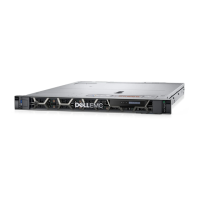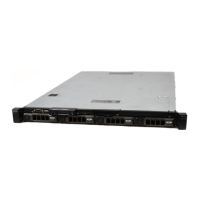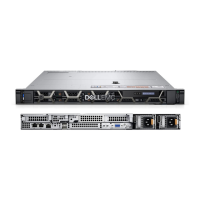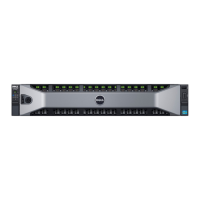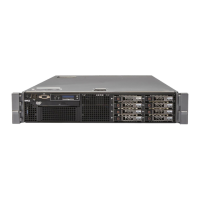Do you have a question about the Dell PowerEdge R420 and is the answer not in the manual?
How to enter System Setup, navigate its menus, and use navigation keys.
Selecting and configuring the system's boot mode (BIOS or UEFI).
Detailed explanations of various configuration screens within System Setup.
Features for setting up, changing, and disabling system and setup passwords.
Guidelines for installing DDR3 DIMMs, including population and configuration.
Procedures for installing various types of hard drives, including hot-swap and cabled.
Guidelines for installing PCI Express expansion cards and risers.
Detailed steps for removing and installing system processors, including heat sink management.
Procedures for installing redundant and non-redundant power supply units.
Important safety warnings and general precautions for system troubleshooting.
Steps to resolve issues preventing the system from booting correctly.
Steps to diagnose and resolve problems related to power supplies and system battery.
Steps to diagnose and resolve problems with installed system memory modules.
Covers troubleshooting for internal USB keys, SD cards, optical drives, and hard drives.
Addresses issues with storage controllers, expansion cards, and processors.
Guide to using the built-in ePSA diagnostics for system hardware assessment.
Comprehensive list of system error codes, messages, and recommended actions.
How to enter System Setup, navigate its menus, and use navigation keys.
Selecting and configuring the system's boot mode (BIOS or UEFI).
Detailed explanations of various configuration screens within System Setup.
Features for setting up, changing, and disabling system and setup passwords.
Guidelines for installing DDR3 DIMMs, including population and configuration.
Procedures for installing various types of hard drives, including hot-swap and cabled.
Guidelines for installing PCI Express expansion cards and risers.
Detailed steps for removing and installing system processors, including heat sink management.
Procedures for installing redundant and non-redundant power supply units.
Important safety warnings and general precautions for system troubleshooting.
Steps to resolve issues preventing the system from booting correctly.
Steps to diagnose and resolve problems related to power supplies and system battery.
Steps to diagnose and resolve problems with installed system memory modules.
Covers troubleshooting for internal USB keys, SD cards, optical drives, and hard drives.
Addresses issues with storage controllers, expansion cards, and processors.
Guide to using the built-in ePSA diagnostics for system hardware assessment.
Comprehensive list of system error codes, messages, and recommended actions.
| Bus type | QPI |
|---|---|
| Stepping | M1 |
| FSB Parity | No |
| Scalability | 2S |
| Processor code | SR0LS |
| Processor cache | 10 MB |
| Processor cores | 4 |
| Processor model | E5-2403 |
| System bus rate | 6.4 GT/s |
| Processor series | Intel Xeon E5-2400 |
| Processor socket | LGA 1356 (Socket B2) |
| Processor codename | Sandy Bridge EN |
| Motherboard chipset | Intel C600 |
| Processor frequency | 1.8 GHz |
| Processor cache type | Smart Cache |
| Processor lithography | 32 nm |
| Processor manufacturer | Intel |
| Processor package size | 45 x 42.5 mm |
| Processor front side bus | - MHz |
| Processor operating modes | 64-bit |
| ECC supported by processor | Yes |
| Supported instruction sets | AVX |
| Thermal Design Power (TDP) | 80 W |
| Number of processors installed | 1 |
| Maximum number of SMP processors | 2 |
| Maximum number of PCI Express lanes | 24 |
| Memory types supported by processor | DDR3-SDRAM |
| Memory channels supported by processor | Triple |
| Memory clock speeds supported by processor | 800, 1066 MHz |
| Memory bandwidth supported by processor (max) | 25 GB/s |
| Maximum internal memory supported by processor | 375 GB |
| HDD size | 3.5 \ |
| HDD speed | 15000 RPM |
| HDD interface | Serial Attached SCSI (SAS) |
| Optical drive type | DVD-ROM |
| Total storage capacity | 300 GB |
| Maximum storage capacity | 12 TB |
| Memory slots | 12x DIMM |
| Internal memory | 4 GB |
| Memory clock speed | 1333 MHz |
| Maximum internal memory | 196608 MB |
| PS/2 ports quantity | - |
| USB 2.0 ports quantity | USB 2.0 ports have a data transmission speed of 480 Mbps, and are backwards compatible with USB 1.1 ports. You can connect all kinds of peripheral devices to them. |
| PCI Express slots version | 3.0 |
| Power supply | 550 W |
| Cables included | AC |
| Compatible operating systems | Windows Server 2008 R2 SP1 Windows Small Business Server 2011 SUSE Linux Enterprise Server Red Hat Enterprise Linux |
| Chassis type | Rack (1U) |
| Processor ARK ID | 64615 |
| Intel Identity Protection Technology version | 0.00 |
| Depth | - mm |
|---|


